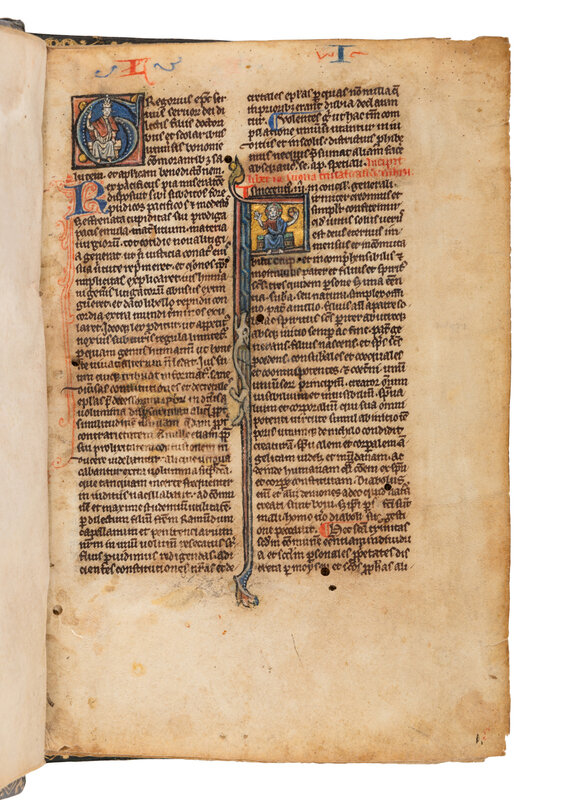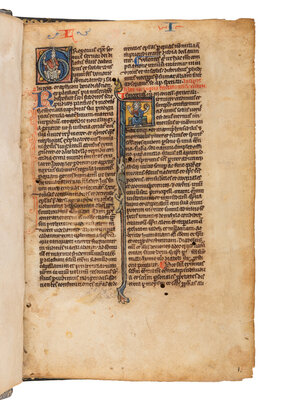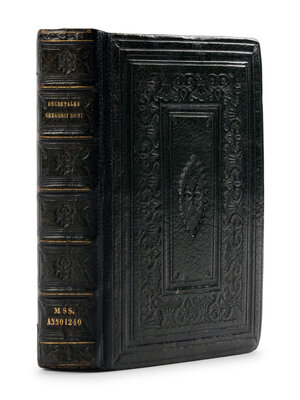Lot 58
ANONYMOUS PARISIAN WORKSHOP
Gregory IX, Decretals, books I-III, in Latin, illuminated manuscript on parchment [France, Paris (?), c. 1250-1275]
Gregory IX, Decretals, books I-III, in Latin, illuminated manuscript on parchment [France, Paris (?), c. 1250-1275]
Sale 2033 - Western Manuscripts and Miniatures
Jun 27, 2024
10:00AM CT
Live / Chicago
Own a similar item?
Estimate
$25,000 -
30,000
Price Realized
$28,575
Sold prices are inclusive of Buyer’s Premium
Lot Description
ANONYMOUS PARISIAN WORKSHOP
Gregory IX, Decretals, books I-III, in Latin, illuminated manuscript on parchment [France, Paris (?), c. 1250-1275]
Gregory IX, Decretals, books I-III, in Latin, illuminated manuscript on parchment [France, Paris (?), c. 1250-1275]
Pocket law manuscripts, like pocket Bibles, were an invention of the thirteenth century and witness a new “everyday” use of the manuscript; with its illumination, this one was costly and suggests a wealthy patron.
120 x 80 mm, ii (modern paper) + iv (sixteenth-century parchment) + 128 + iii (modern paper) leaves, complete (collation: i-xv8, xvi6, xvii-xxiii8), with occasional catchwords and quire signatures throughout, modern pencil foliation in black ink in the lower right corner, ruled for two columns of 40 lines (written space: 82 x 58 mm), rubrics in red, additions and pen doodles throughout, sections titles in the lower margin of each verso, and added in a fifteenth-century hand in the upper right corner of each recto, running titles and one-line initials throughout alternately in red and blue, larger flourished penwork initials throughout alternately in red and blue with penwork in the contrasting color, FOUR HISTORIATED INITIALS in red and blue on gold or blue ground (first two historiated initials overpainted in the late 20th century, signs of use over several centuries, the upper right corner of folios eaten throughout, damp stains on f. 1 and 125-126 not altering the legibility of text, many leaves worn). Bound in a nineteenth- or twentieth- century green blind-stamped morocco binding, spine with five raised bands gilt, titles gilt “Decretales Gregorii Noni” and “Mss. Anno 1240”), marbled pastedowns and first flyleaves, corners a bit smudged, else in good condition).
In 1230, Pope Gregory IX (1227-1241) directed his chaplain and confessor, the Dominican Raymond of Peñafort (c. 1175-1275), to compile a new collection of canon law to bring Gratian’s Decretum, from the mid twelfth century, up to date. The Decretals of Gregory IX, also known as the Liber Extra (the book outside Gratian’s Decretum), was sent to the universities of Paris and Bologna, and promulgated in 1234. It became the first collection of canon law for the Catholic Church invested with papal authority, controlling many aspects of both secular and clerical life. Its utility is made clear by the number of surviving Latin manuscripts (Martin Bertram, Online Resources, lists 675), making it a true “best seller.” The Decretals were divided into five books (Iudex, Iudicium, Clerus, Connubia/Sponsalia, and Crimen (that is, Judge, Trial, Cleric, Marriage, and Crime), and again into sections related to specific themes, known as tituli (185 in total). Further research could focus on the evidence of original ownership in the extant volumes – monastic, secular, clerical, university.
Although complete in itself, this pocket-sized manuscript only contains the first three books of the Decretals: Judge, Trial, and Cleric. Perhaps, therefore, it was commissioned by the abbot of a monastic institution, who would not have had use of the books of Marriage and Crime, related to secular life. Indeed, this manuscript was evidently made for use, as the tituli were copied in the lower margin of each verso and listed again at the end of the volume. The manuscript was still in use in the fifteenth century, when the tituli were again copied in the upper right corner of each recto, allowing for convenient browsing of the volume.
Provenance
(1) Based on the style of the decoration, this manuscript appears to have been written, decorated, and illuminated in France, most likely in Paris, in the third quarter of the thirteenth century. The textual peculiarities suggest that its patron was an abbot.
(2) It remained in France in the sixteenth century, based on the script and content of a short poem written on an added quire of parchment leaves, beginning “La fin couronne l’œuvre.”
(3) The manuscript belonged to a “Jacobus Gast,” likely in Germany, whose ex-libris dated 1569 is written on the first folio of the modern parchment quire.
(4) New York, Scott Schwartz, his MS 39, according to his label on the front pastedown.
Text
Gregory IX (c. 1145-1241), Decretales Gregorii IX: ff.1-62v, Book I; ff. 62v-118, Book II; ff. ff. 118v-181, Book 3; ff. 181v-182, list of rubrics.
Illumination
This volume offers a refined decoration of penwork initials throughout, associated with four historiated initials that introduce the dedication and the beginning of each book. The first and second historiated initials appear to have been repainted in the late twentieth century, probably because of earlier damages. The figures of the third and fourth initials, with their flat folds and combed hairs, are reminiscent of manuscripts illuminated in Paris in the third quarter of the thirteenth-century, although the size does not facilitate their attribution.
The subjects of the historiated initials are: f. 1, Pope Gregory IX (initial G); f. 1, Christ Judge, enthroned, blessing, and holding the orb (initial P); f. 62v, A judge and a man (initial D); f. 118v, A Cleric blessing (initial V).
LITERATURE
For further literature, see Susan L’Engle and Robert Gibbs, Illuminating the Law, Legal Manuscripts in Cambridge Collections, 2001, esp. pp. 15-19, 69-71.
Freeman’s | Hindman thank Senior Consultant Sandra Hindman and Elliott Adam for their assistance in preparing this sale.
Condition Report
Contact Information



